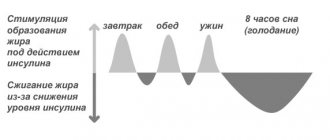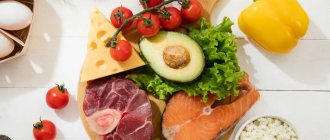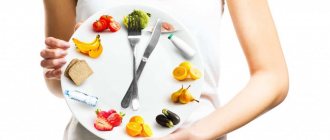© IgorVetushko — depositphotos.com
Share:
Finding effective diets for weight loss is a favorite pastime of all housewives. However, the approach in the spirit of “what should I eat to lose weight” does not always justify itself. Moreover, many advertised diets are dangerous to health.
Often things reach the point of absurdity when home-grown “nutritionists” take the principle of sports nutrition with “vigorous” modifications and pass it off as a complete and extremely effective weight loss system. This is exactly the fate that befell the BUTCH diet, which was not originally intended for the general public.
What is BUCH?
Before describing the principles of nutrition, the dangers and benefits of this method, we will answer the question, what is BEAM?
The abbreviation BUC stands for protein-carbohydrate alternation. This is not even a diet, but a way of eating based on the basic principles of rational calorie consumption and calculating BZH using periodization. If you add the word “diet” to this, you get a substitution of concepts. When people talk about the BUT diet, they mean an extremely small part of the principle of periodization of nutrition, which is not effective enough compared to the general principles. In addition, the main task of alternation is not in losing weight, but in drying.
So, protein-carbohydrate alternation is as follows:
- A calorie deficit is created by completely eliminating carbohydrates on certain days.
- By cutting out carbohydrates, the body depletes glycogen reserves.
- In the next 2-5 days, the body, which has not had time to rebuild itself, uses adipose tissue as the main fuel.
- To avoid catabolism and muscle tissue breakdown, it is recommended to consume increased amounts of protein on carbohydrate-free days.
- On the 3-6th day, a “carbohydrate load” occurs, which deceives the body, not putting it into “economy mode”.
Important: to deplete glycogen reserves, you will have to exercise at high intensity, otherwise periodization will lead nowhere. Without critical loads, the body will reduce glycogen consumption and begin to break down muscle tissue, which will not lead to the weight loss you wanted!
In words everything is simple. In fact, even experienced athletes consider protein-carbohydrate alternation one of the most stringent nutritional plans. It requires the use of scales, eating according to the clock and incredible willpower.
Note: unlike classic diets, problems begin with individual nutritional adjustments, since in conditions of periodization it can take longer than the diet itself.
Before using BEAM you need to learn:
- Calculate the number of kilocalories consumed on training and non-training days.
- Calculate the calorie content of food.
- Skillfully determine the glycemic index and carbohydrate load.
- Understand what “green carbohydrates” and “fiber” are.
- Adjust nutrition in accordance with the current state of the body.
- Determine the period of digestion of various types of proteins.
If you are in periodization mode for a long time, you will have to stock up on T3 hormones and digestive enzymes to avoid the development of a pre-diabetic state. Additionally, you need to have a budget to support your body on no-carb days.
As can be seen from the basic tenets of nutrition, protein-carbohydrate alternation is not intended for people who do not exercise. In other words, for housewives with low physical activity, periodization will be ineffective - rather, on the contrary, it will lead to even greater weight gain.
Nutritionist opinion
Nutritionists consider this method of losing weight gentle.
The diet eliminates hunger strike, the body receives a sufficient amount of proteins and complex carbohydrates. But experts do not recommend sticking to a nutrition plan for a long time, because... Such a diet almost completely excludes the fats necessary for the body. It's better to take vitamin supplements.
With this method, people manage to lose 2-3 kg in 1 week. The diet is relatively easy to tolerate, as confirmed by reviews.
Main advantages
We hope readers have already understood that BUTCH is not just another diet for weight loss. Now let's figure out why this principle of nutrition has gone beyond bodybuilding and has become popular not only among athletes, but also among ordinary citizens.
Protein-carbohydrate alternation is really effective when done correctly. There are many reasons for its popularity:
- No feeling unwell during drying.
- High rate of weight loss during periods of no carbohydrates.
- Minimization of catabolic processes.
- There are no metabolic disorders. After a diet, if exited correctly, there is no rebound effect.
- Maximum preservation of muscle mass while losing body fat.
If the principles of alternation were not so difficult to implement, this approach to nutrition could be called ideal.
Does this diet have any disadvantages?
Periodization in nutrition was originally developed for bodybuilders in preparation for performances.
All of its disadvantages follow from this, because of which it has not found widespread use even among athletes:
- High level of difficulty.
Even if you follow all the principles, you will have to adjust your diet. This will require several cutting cycles to determine the optimal ratio of days/calories/protein/carbohydrates. - Inability to use on an ongoing basis. The principle of alternation is to shock the body and deceive it. However, after 30 days of such exhaustion, a chronic lack of glycogen, which is usually not restored in full during the loading days, will lead to a slowdown in metabolism and, accordingly, to leveling out the results.
- The principle of the pendulum. In fact, periodization means that a person loses weight for two days and gains one day. If you give in on a busy day or make a mistake in periodization, instead of a minus you will see a solid plus on the scales.
Despite its effectiveness, this is a potentially unhealthy diet.
© Andreus — depositphotos.com
While following the BUCH, the following problems are possible:
- decreased productive function of the thyroid gland;
- dangerous increase in load on the gastrointestinal tract;
- constipation;
- sudden mood changes;
- development of gastritis, pancreatitis and other gastrointestinal diseases;
- general weakening of the body at the end of the cycle;
- decrease in speed and strength indicators;
- increased likelihood of developing diabetes;
- development of kidney failure and other kidney problems;
- change in the ratio of digestive enzymes.
And this is not a complete list of unpleasant and harmful changes in the body during long or incorrect alternation.
Protein-carbohydrate alternation is contraindicated:
- with vitamin deficiency;
- predisposition to gastritis and duodenal ulcer;
- lack of digestive enzymes;
- lactation;
- renal failure;
- lack of physical activity;
- weak heart;
- impaired metabolism;
- predisposition to diabetes;
- during menstruation.
You cannot practice such nutrition during the period of growth and development of the body (that is, up to 23 years).
Despite all these side effects, the diet continues to be promoted quite aggressively by various “dietology experts.”
Additional Tips
To get rid of extra pounds faster and more effectively, you need to introduce constant physical activity into your lifestyle.
During the thirty-day buckwheat diet, it is better to refuse to engage in heavy sports, as the body will be exhausted. It is better to give preference to daily exercises or light evening walks.
The following recommendations are given for the diet itself:
- It is better to choose cereals with whole rather than crushed kernels. It contains more useful components.
- Before pouring water or kefir into the buckwheat, you need to rinse it several times in cold water.
- Buckwheat can be eaten not only in the form of porridge, but also in the form of cutlets, pancakes, casseroles or lean soup. This is especially useful when going off a diet.
- For breakfast, you can drink buckwheat with unsweetened green tea to better satisfy your hunger and further cleanse the body.
- Half an hour before your first breakfast, it is advisable to drink a glass of warm water with honey and lemon.
Since the 30-day buckwheat diet is not suitable for everyone, you should consult your doctor before using this technique, especially if you have chronic diseases in the cardiovascular or digestive system.
How to eat properly?
How to correctly create a protein-carbohydrate alternation?
To do this you need to do several things:
- Calculate the number of kilocalories consumed separately for training and non-training days. Already at this stage many people have problems. The main one is that only by knowing the kilocalorie consumption on training days can you correctly calculate the load. Standard numbers (1200-1500 kcal) will not work.
- Calculate your own net weight (without body fat).
- Next, based on net weight, calculate the required amount of proteins.
- On protein days there are no carbohydrates at all; the only exception can be made for carbohydrates contained along with fiber in green vegetables (up to 50 g of carbohydrates).
- On fasting days, you should not greatly exceed your calorie intake. It is enough to restore the glycogen reserve that was depleted during the first day of training. Those. calorie content should not exceed 110% of that spent on the first training day.
- Some of the caloric deficit on no-carb days can be offset by using small amounts of omega 6 fats.
Proteins are calculated as follows:
- 3 hectares of complex proteins (whey + casein + missing amino acids) per kilogram of net weight on a training day;
- 2 hectares of complex protein on a non-training day;
- 1 g of protein per kilogram of body per day of carbohydrates.
Let's consider an approximate calculation of calorie content, which you need to focus on when preparing your diet.
What products are there?
"Correct" carbohydrates
A protein-carbohydrate diet requires so-called complex carbohydrates. They provide a long-lasting feeling of satiety and provide more energy for active life. You can find them:
- in any porridge, except semolina;
- in pasta products made from durum wheat;
- in bread with whole grains;
- in fruits with low sugar content;
- in vegetables (excluding potatoes), herbs.
The daily value can be calculated using the formula: your weight multiplied by 3. The final figure is the amount of carbohydrates in grams. So, for example, if you weigh 60 kg, you are allowed to eat 180 grams of carbohydrates, which is 2 kg 250 grams of apples for the whole day.
On a note! How to find out how many grams of carbohydrates are in a particular product? Such information can be read from the packaging. But what if there is no label? For example, how to find out the “cherished number” for carrots? To do this, use the Calorie Calculator.
Protein products
Eligible Products
Let's find out what you can eat while following the protein-carbohydrate alternation.
Protein
Protein sources are complex. 60% casein protein should provide a long-lasting feeling of fullness. Another 30% comes from complete “egg/meat” protein, which supplies the body with all the necessary amino acids. The remainder is milk/whey protein.
What is allowed:
- skim cheese;
- whey, milk, kefir, eggs.
- lean steamed meat, fish, or boiled chicken breast.
© firstblood — depositphotos.com
What is prohibited:
- fried meat;
- fat meat;
- full fat milk;
- sour cream.
Carbohydrates
Sources of carbohydrates are exclusively complex carbohydrates. On loading days, small amounts of fructose are allowed.
What you can eat:
- green vegetables (onion, celery, cucumber, etc.), potatoes;
- porridges with a low glycemic index - oatmeal, buckwheat, rice;
- whole grain bread with bran (in extremely low quantities);
- fiber-rich foods.
© bit245 — depositphotos.com
What not to do:
- soda;
- products containing sugar;
- corn porridge;
- carbohydrates with a high glycemic index (baked goods, pastries, bread);
- muesli - due to the presence of cereals with a high glycemic index.
Fats
As for fats, if desired, salads can be seasoned with olive oil. Fish oil is allowed. These are all sources of Omega 3. Anything else is not recommended.
© OllyKava — depositphotos.com. Omega-3 content per 100 g of product
On a BEACH diet with Tatyana Fedorishcheva
Before losing weight, on the advice of video blogger Tatyana Fedorishcheva, you should prepare: decide on a list of products and take measurements of your figure in order to clearly see how the process is going, how excess weight and centimeters are lost. This is a kind of motivation.
Measurements can be taken in two ways: only chest, waist and hip girth, or add biceps girth, thigh (one) and calf girth. Write down the results on a separate piece of paper and set the date. You can also take a photo in a swimsuit or underwear.
Approximate list of products for the next 21 days:
- “milk”: milk, kefir, sour cream, fermented baked milk, cheese with the lowest fat content, cottage cheese, butter;
- eggs;
- seasonal vegetables (except potatoes), herbs (to choose from), fruits;
- bird, fish;
- cereals: rice, oatmeal, buckwheat;
- fiber, nuts, honey.
Calculation example
A 92 kg man with a body fat percentage of 18%, actively involved in sports 3 times a week. The average kilocalorie consumption on training days is 3000-3500. On non-training days 2000-2500. Net weight – 75 kg.
Based on this, on a carbohydrate-free day its calorie content will be calculated as:
- 75*3 – 225 g protein – 924 kcal.
- 30-50 g of green carbohydrates (less if possible) – 123 kcal.
- 5-10 g omega 6 fats – 92 kcal.
The total calorie intake is 1140 kcal on a carbohydrate-free day. The total kilocalorie deficit is about 2000 kcal per training day. Standard cycle BUCH – 4/1.
On the day of loading, his meals should be:
- 75 g protein – 308 kcal.
- 5-10 g omega 6 fats – 92 kcal.
- Total calorie content is 3500-3850 kcal.
- This means that the remainder falls on carbohydrates - up to 700 g of carbohydrates. Mostly complex.
The total weekly kilocalorie deficit is about 4000-5000 kcal. When converted to adipose tissue, this amounts to 444 hectares of fat per week. 0.44 kg of 17 kg body fat is about 2.5% of body fat weekly, or 10% of body fat loss per month. Those. at the end of the month, the man will have lost 89-90 kg, having reduced the body fat to 17.2%.
Attention: after seeing the calculations, many will consider the result low. However, keep in mind that the example used was an athlete with a small amount of body fat (about 18%).
For people with a higher fat ratio, weight loss will be more significant. So, for example, for a person weighing 92 kg, with a fat ratio of about 35%, weight loss per month will be about 6-7 kg. This once again confirms the fact that the diet is intended for pure cutting (reducing fat while preserving muscle), and not for pure weight loss, in which all tissues are burned.
Menu for a low-carb day
Editor's note: This section is presented for informational purposes only. The principles of menu design are indicated in the previous section.
The menu for a no-carbohydrate day is generally similar to a no-carbohydrate diet. The number of meals is divided by 5. The total calorie content is up to 1400.
© belchonock — depositphotos.com
Detailed daily food menu:
| 1st meal: |
|
| 2nd meal: | Protein shake, or 350 ml of whey. |
| 3rd meal: | Baked low-fat meat. Fish or chicken + avocado or other green vegetable 30 g. |
| 4th meal: | Kefir/yogurt – 1 l. |
| 5th meal: |
|
Menu for carbohydrate day
| 1st meal: |
|
| 2nd meal: |
|
| 3rd meal: |
|
| 4th meal: |
|
| 5th meal: |
|
You can download and print both menus using the link.
Features of thirty-day weight loss
All varieties of buckwheat diet can be divided into strict and gentle. A strict diet consists of only fresh porridge and water or green tea, and it is possible to lose up to 1 kg per day, which can be seen not only on the scale, but also externally.
Nutritionists do not advise continuing such a diet for more than 3 days, and eating buckwheat alone for a whole month is out of the question. In order not to harm your own health, you should not conduct such experiments.
To survive 30 days on a buckwheat diet, you need to add other low-calorie foods to your diet. The effect of losing weight will not be so obvious, but the body will not suffer. In any case, during the buckwheat diet you should adhere to the following principles:
- The cereal is not boiled, but steamed, as this allows the maximum preservation of useful components in it. In the evening, buckwheat is poured with boiling water, or better yet warm water, and left under the lid until the morning. Each time before eating, a portion is heated in the microwave.
- No salt, spices, oil or sauces are added to the porridge. The taste will be bland and tasteless, but you need to endure it to achieve the desired result.
- You need to eat small portions 5-6 times a day. If you adhere to this principle for a long time, you will be able to relieve the digestive system, reduce the size of your stomach and reduce your appetite.
- Since the diet includes a complete ban on salt, excess fluid will gradually be removed from the body. To replenish the balance, you need to consume at least 1.5 liters of clean water without gas per day.
- It is advisable to have meals at regular intervals, with the last meal being at least 4 hours before bedtime.
Not everyone can lose weight on a buckwheat diet for a month. Long-term consumption of porridge can lead to a decrease in blood pressure, so the method is contraindicated for hypotensive people.
In addition, cereals can negatively affect the digestive system if there are any diseases or predispositions to them. In general, you need to listen to your condition and cancel the diet if you feel unwell.
Gentle variation (used/used)
There is a gentle version of the diet. Its effectiveness remains controversial in both the short and long term. However, it is obvious that it causes significantly less harm to the body and can become a replacement for classic calorie counting, which will provide up to 1-2 kg of weight loss monthly. An approximate butch diet plan with a menu for every day in a gentle version can be found in the table below.
Protein and carbohydrate days are similar to the previous points. For the bookkeeping day, the calculation is as follows:
| 1st meal: |
|
| 2nd meal: | Protein shake, or 350 ml of whey. |
| 3rd meal: | Baked low-fat meat. Fish or chicken + avocado or other green vegetable 30 g. |
| 4th meal: |
|
| 5th meal: |
|
The selection of products is not necessarily rigid. It is enough to select analogues with a similar amount of BJU per 100 g of weight.
Fully or partially limited products
The following foods are excluded from the BEACH diet:
- fatty varieties of red meat (pork) and meat products (sausages, ham, lard, bacon, smoked meats), fast food;
- sugar and products containing it - candies, halva, jam, cookies, chocolate, dried fruits, condensed milk, ice cream, sweet desserts;
- It is not allowed to consume potatoes in any form, baked goods, whole/diluted milk, wheat bread, crackers, cakes, gingerbreads, waffles, or non-whole grain porridge;
- sweet fermented milk and fatty dairy products;
- sweet fruits (pineapple, watermelon, grapes, persimmon) and juices from them, caffeine-containing products;
- alcohol and carbonated drinks.
Table of prohibited products
| Proteins, g | Fats, g | Carbohydrates, g | Calories, kcal | |
Vegetables and greens | ||||
| fried potato | 2,8 | 9,5 | 23,4 | 192 |
| radish | 1,2 | 0,1 | 3,4 | 19 |
| turnip | 1,5 | 0,1 | 6,2 | 30 |
| beet | 1,5 | 0,1 | 8,8 | 40 |
Fruits | ||||
| figs | 0,7 | 0,2 | 13,7 | 49 |
Berries | ||||
| grape | 0,6 | 0,2 | 16,8 | 65 |
Mushrooms | ||||
| mushrooms | 3,5 | 2,0 | 2,5 | 30 |
Nuts and dried fruits | ||||
| raisin | 2,9 | 0,6 | 66,0 | 264 |
| dates | 2,5 | 0,5 | 69,2 | 274 |
Cereals and porridges | ||||
| corn grits | 8,3 | 1,2 | 75,0 | 337 |
Flour and pasta | ||||
| pancakes | 6,1 | 12,3 | 26,0 | 233 |
| vareniki | 7,6 | 2,3 | 18,7 | 155 |
| dumplings | 11,9 | 12,4 | 29,0 | 275 |
Bakery products | ||||
| buns | 7,2 | 6,2 | 51,0 | 317 |
| wheat bread | 8,1 | 1,0 | 48,8 | 242 |
Confectionery | ||||
| jam | 0,3 | 0,2 | 63,0 | 263 |
| jam | 0,3 | 0,1 | 56,0 | 238 |
| candies | 4,3 | 19,8 | 67,5 | 453 |
| cake | 3,8 | 22,6 | 47,0 | 397 |
| jam | 0,4 | 0,2 | 58,6 | 233 |
| halva | 11,6 | 29,7 | 54,0 | 523 |
Cakes | ||||
| cake | 4,4 | 23,4 | 45,2 | 407 |
Chocolate | ||||
| chocolate | 5,4 | 35,3 | 56,5 | 544 |
Raw materials and seasonings | ||||
| ketchup | 1,8 | 1,0 | 22,2 | 93 |
| mayonnaise | 2,4 | 67,0 | 3,9 | 627 |
| honey | 0,8 | 0,0 | 81,5 | 329 |
| sugar | 0,0 | 0,0 | 99,7 | 398 |
Dairy | ||||
| condensed milk | 7,2 | 8,5 | 56,0 | 320 |
| cream | 2,8 | 20,0 | 3,7 | 205 |
| fruit yogurt 3.2% | 5,0 | 3,2 | 8,5 | 85 |
Meat products | ||||
| fatty pork | 11,4 | 49,3 | 0,0 | 489 |
| salo | 2,4 | 89,0 | 0,0 | 797 |
| bacon | 23,0 | 45,0 | 0,0 | 500 |
Sausages | ||||
| smoked sausage | 28,2 | 27,5 | 0,0 | 360 |
| dry-cured sausage | 24,1 | 38,3 | 1,0 | 455 |
Bird | ||||
| duck | 16,5 | 61,2 | 0,0 | 346 |
| goose | 16,1 | 33,3 | 0,0 | 364 |
Fish and seafood | ||||
| fried fish | 19,5 | 11,7 | 6,2 | 206 |
| smoked fish | 26,8 | 9,9 | 0,0 | 196 |
| canned fish | 17,5 | 2,0 | 0,0 | 88 |
Alcoholic drinks | ||||
| white dessert wine 16% | 0,5 | 0,0 | 16,0 | 153 |
| vodka | 0,0 | 0,0 | 0,1 | 235 |
| cognac | 0,0 | 0,0 | 0,1 | 239 |
| liquor | 0,3 | 1,1 | 17,2 | 242 |
| beer | 0,3 | 0,0 | 4,6 | 42 |
Non-alcoholic drinks | ||||
| bread kvass | 0,2 | 0,0 | 5,2 | 27 |
| cola | 0,0 | 0,0 | 10,4 | 42 |
| coffee with milk and sugar | 0,7 | 1,0 | 11,2 | 58 |
| Pepsi | 0,0 | 0,0 | 8,7 | 38 |
| energy drink | 0,0 | 0,0 | 11,3 | 45 |
Juices and compotes | ||||
| compote | 0,5 | 0,0 | 19,5 | 81 |
| grape juice | 0,3 | 0,0 | 14,0 | 54 |
| * data is per 100 g of product | ||||
Entry and exit from the diet
If, despite everything, you still decide to try protein-carbohydrate alternation, we hasten to disappoint you: nothing will work out on the first try. The fact is that your body does not yet know how to adapt to using adipose tissue as a backup nutrition. Most likely, already on the 2nd day of giving up carbohydrates, your health will worsen and your metabolism will slow down.
Advice: you should first try several cycles of a carbohydrate-free diet. But even so, the protein-carbohydrate rotation is aimed at the long-term pendulum. This means you need to enter the diet correctly and exit it correctly.
How to do it correctly:
- A week before the start of BCH, you need to calculate your daily consumption and kilocalorie consumption.
- For 7 days, you need to reduce your calorie intake by 10%, thus creating a small deficit.
- On the day before starting the diet, it is recommended to do a small deload.
© anaumenko — depositphotos.com
And only after that start alternating. This input will allow the body to react more softly to changes in nutrition, which is especially important for people who do not exercise or are going dry for the first time.
It looks something like this:
- Kcalorie consumption – 3000, consumption – 2500.
- On the second day, consumption is 2700, consumption is 2500.
- On the third day, consumption is 2430, consumption is 2500 (the first signs of a deficit).
- On the fourth day, consumption is 2200, consumption is 2400 (we reduce the level of training loads).
- Consumption – 2000, consumption – 2300.
- 6th consumption – 1800, consumption – 2300.
- 7th consumption – 2500, consumption – 2500.
We exit the diet in reverse order. At the same time, it is important that the exit from the diet begins after a day of loading with carbohydrates (and not unloading).
Difficulties of the BUTCH diet
Like I said earlier, this diet is SUPER EFFECTIVE, but it does come with some challenges. It requires customization!
It's easy to make a mistake, so you'll need to experiment a little with the following options:
- The size of the “carbohydrate load” (by day and by amount of carbohydrates).
- Number of carbohydrate-free days.
Now I’ll explain a little. The fact is that you can overdo it with the number of days or, on the contrary, they may not be enough.
For one person, already on day 3, the metabolism will begin to slow down, while for another, on this day there will be the peak of fat burning. Someone can generally sit on a carbohydrate-free diet for a whole week and actively get rid of fat; if at this time they avoid a lot of carbohydrates, then fat burning will completely stop.
Now about “carbohydrate loading”, it can be excessive or insufficient. For some, it will be enough to eat a good plate of rice for breakfast and lunch and that’s it, they’ve successfully booted up and their metabolic rate has been restored.
And someone will crack chocolate for a couple of days and still be “underloaded.”
Another important point! This is WHAT CARBS YOU EAT. Namely: there are fast (sugar, chocolate, fruit, etc.) and slow (brown rice, buckwheat, pearl barley, etc.).
It's not all that simple. For example, I noticed that fast carbohydrates work well for me, i.e. I can afford to load myself up with chocolates, but I can eat rice too.
I won’t tell you absolutely exact numbers that will work for everyone, because... In principle, such things do not happen. An ectomorph may need a carbohydrate load after just two days, while an endomorph will still be in the fat burning phase after 5 days. You just have to experiment and find out for yourself.
I will give you an approximate framework of how such a diet can work for the majority, but you need to decide for yourself how to move in one direction or another.
So first I would try:
- 3 days without carbohydrates;
- 1 day of “carbohydrate loading”;
I would pay attention to my well-being, to the scales and to the reflection in the mirror. If you still feel great, there is no impotence, the weight continues to fall, and your reflection in the mirror continues to improve, then I would add another 1-2 days of no carbohydrates.
And if you can barely stand on your feet, you have cold sweats, your weight stays the same, and your reflection does not change, then I would reduce 1 day of no-carbohydrate and experiment with carbohydrates.
- FEELING GOOD = add no-carb days.
- FEELING BAD = reduce the number of carb-free days and add more carbs to your load.
- THE MIRROR SHOWS PROGRESS AND THE WEIGHT FALLS = you don’t have to change anything for now.
- THE MIRROR DOES NOT SHOW PROGRESS AND THE WEIGHT STAYS STAY = you need to change unloading and loading.
In short, you must experimentally ensure that you lose weight on the scale and in the mirror (fat burning works), but feel good (metabolism does not slow down).
As I said, for most people the following scheme will work: 3 days without carbohydrates + 1 day of loading, but I would also like to advise that on the day of loading there are carbohydrates not all day, but only in the first half of the day.
Also decide what works best for you: simple carbohydrates (sweets) or complex carbohydrates (porridge). If you load only in the morning, you can do it with simple carbohydrates, but if your load lasts 2 days, then it is better to use complex carbohydrates. Again, you need to experiment.
What to combine with?
Note: This section is intended for professionals only.
Protein-carbohydrate alternation practically does not reduce training performance. However, if your goal is to reduce body fat as much as possible in the pre-competition period and you are not using testosterone metabolites (i.e. androgenic steroids), then certain supplements will enhance the effectiveness of your training.
These include:
- L-carnitine. On an ongoing basis, in order to increase performance during training - 2-3 capsules 30 minutes before classes. (Read here in detail about how to take l-carnitine).
- BCAA 2-1-1. To reduce catabolic processes in muscles. Exclusively after training, since otherwise the amino acids will not go into the muscles, but as energy. (here are details on how to take bcaa).
- ECA (and its analogues) in the minimum permissible dosage. Use is allowed only if the carbohydrate load coincides with the training day. The drug will allow you to continue to burn fat tissue, despite the presence of glycogen in the blood.
- Clenbuterol and its analogues - in half the dose on protein days that coincide with training. Clen is a powerful thermogenic that stimulates lipolysis in the blood.
© lecic — depositphotos.com
And one more important point: no matter how much you want to dry out, it won’t work without changing your training plan. Be sure to add cardio exercises in the fat burning pulse zone.
What happens to the body during the BEACH diet
- First, on the very first day, the body loses glycogen stores in our muscles and liver.
- Then (on the second and third days), due to the loss of glycogen reserves, the body actively begins to burn fat.
- Further, while maintaining a low-carbohydrate regime, the body's anti-stress adaptation is activated, caused by a lack of energy, which is aimed at maintaining weight (increased secretion of catabolic hormones, deterioration of thyroid hormones, decreased insulin secretion, slower conversion of fat into glucose, etc.). In short, metabolism slows down, because... the body tries to maintain weight, because... he considers lack of energy a threat to life.
- If we don’t add energy (carbohydrates), then we can stop the fat burning process altogether, but we don’t need this, so for the next period (1-2 days) we load ourselves with carbohydrates in large quantities.
Dangerous advertising variations
Unfortunately, the BEACH diet has many simplified schemes. The purpose of all these miracle techniques and simplifications is to popularize the diet. To do this, sellers of the “miracle nutrition” use the performance data from the classic rotation and do not mention possible side effects. At the same time, a huge list of products is offered as a menu; the principles of the diet are often violated.
This leads to the following consequences:
- Reducing the effectiveness of the diet. Yes, it becomes safe, but the pendulum can show on the scales is not at all a minus.
- Increasing intensity. This happens when women try to rape their bodies with milkweed and other nonsense. Then such a diet has a more stringent caloric restriction (which does not always coincide with consumption), and ensures rapid loss of water and muscles in the shortest possible time. The result on the scale is stunning (up to 7-10 kg per week), but if you stick to such an express diet for a long time, you risk going to the hospital.
Let's consider the most dangerous options for BUCH power supply.
Malysheva's diet
There is no point in going into detail about this diet.
Let's just list the reasons why its effectiveness is questionable:
- Strict link to the number of calories (without initial data, consumption, consumption, weight, body fat).
- The presence of a fixed 2/1/1 scheme (2 no-carb, 1 half-and-half, 1 carbohydrate load). Without individual adjustments, the chance of meeting exactly this nutritional balance is approximately 7-10% of all those who tried it.
- Not a word about the use of glycogen and the need for physical activity.
- There is no entry or exit from the diet.
Even if we remove all questions regarding the danger, followers of BUCH Malysheva will face an inevitable rollback effect when, upon exiting the diet, the weight returns in excess.
© Ariwasabi — depositphotos.com
Powell Diet
The Powell diet is the other side of the coin. It is relatively effective, although dangerous. The main disadvantage of the Powell diet is that it is not a protein-carbohydrate alternation. This is an alternation of low-carb and high-carb days at a fixed caloric intake.
This means that if you follow all the principles described in the diet, its effectiveness will be approximately equal to a low-carbohydrate diet. Again, a fixed calorie content does not take into account the real needs of the body, so figures of 1200-1500 kcal, although they create a deficit, are often excessive for people leading a more or less active lifestyle.
And most importantly: the duration of the Powell cycle is 3 months, while even the most stringent versions of a low-carb diet have a periodization (6 weeks of diet, week of a smooth exit).
Recipes for healthy eating
Recipe for rice porridge with milk
- 2.9 g Protein
- 3.1 g Fat
- 15.9 g Carbohydrates
- 97 kcal
30-40 min.
- #vegetarian dish
- #dietary
- #breakfast
- #raisin
- #porridge
- #cinnamon
- #milk
- #flour
- #low calorie
- #dinner
- #rice
- #condensed milk
- #butter
- #dinner
- #egg
Other recipes
Advantages and disadvantages
| pros | Minuses |
|
|











